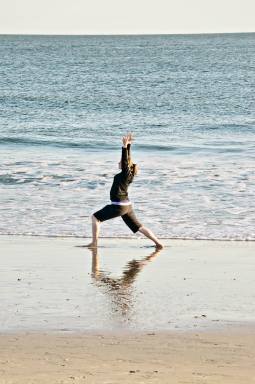Yesterday I talked about a few articles that denounce yoga as being inappropriate for Christians to practice. I don’t agree with that assessment, and I think that those who believe that way are taking a far too narrow view. Today I want to talk about just a few of the reasons why I think yoga can be used by and helpful to anyone regardless of their religious background.
One thing that has struck me in my own practice and reading was how similar the Bhagavad Gita is to the Gospels. A LOT of what Krishna tells Arjuna could have been said by Jesus to Peter and have made perfect sense. I would actually love to hear from someone who has read both the Gita and the Gospels closely, because to me the parallels seem numerous and meaningful.
To say that “attaining enlightenment through Krishna” is different from “reaching the kingdom of heaven through Jesus” is to quibble over vocabulary and culture, I think, and to argue over what face you want to put on your version of the divine. Christians put one face on the divine, Hindus another, Muslims still another, but at heart, we’re talking about the same guy here. In practical terms, the emotion and feeling that a Christian puts in to worshipping Jesus is going to be very similar to the emotion and feeling that a Hindu or a Bhakti yogi puts in to worshipping Krishna. The rituals may be different, but they’re doing the same thing.
Over the past year, yoga has helped me realize just how similar the major religions are in many ways. On a technical theological level, the core beliefs of Buddhism or Hinduism aren’t going to be compatible with the core beliefs of Christianity, but on a moral and ethical level, they’re nearly identical, and on a spiritual level, we’re all striving for the same thing: to become closer to our version of God. Whether “God” means Yahweh or Jesus or Krishna or the universal consciousness, it doesn’t matter. There are many names for God and many metaphors for God. We’re all blind men touching a different part of the elephant, but it’s all the same elephant: the trunk, ears, feet, and tail are all parts of the same thing, no matter how different they seem individually.
While yoga has a strong and beautiful background in Hindu tradition, that doesn’t necessarily define it as a Hindu practice. The tools set out in the yoga texts are, I feel, applicable to any sort of spiritual searching – and I believe that Christians and all people should take part in spiritual searching to become closer to their God. All of my reading this year has helped me to confirm for myself that I’m not a Christian, but that wasn’t due to the yoga – I pretty much knew that already. Yoga could have the complete opposite effect on a devout Christian, helping her to come into a deeper communion with her faith. For example, people in many different religious faiths practice meditation – a Buddhist practicing meditation doesn’t become a Hindu or vice versa, because the meditation simply brings the practitioner closer to her own concept of the divine. If you look at the definition of meditation, saying the rosary is actually a meditation practice – the chanting and repetition of certain words or prayers to bring one closer to God. There are many ways to meditate, many ways to seek, many ways to pray.
I welcome thoughtful discussion on this topic, as well as links to articles or further information. I may come back to this again, since I really feel like I’m only skimming the surface here.




